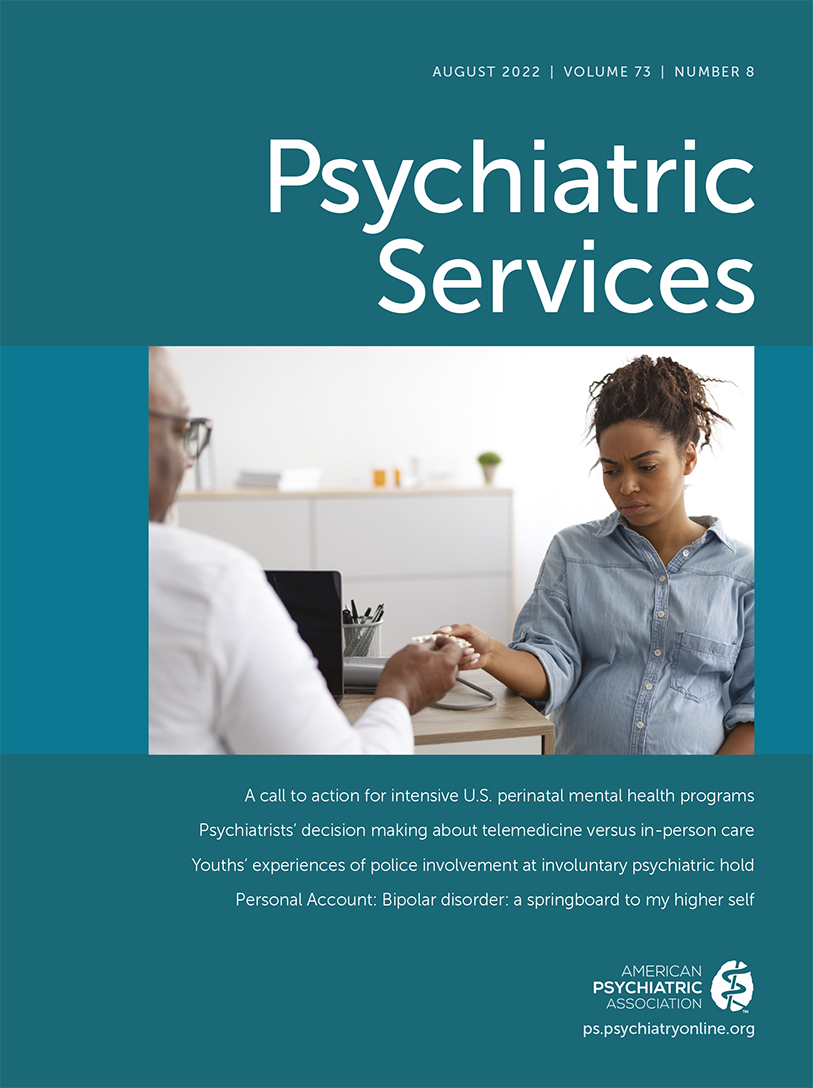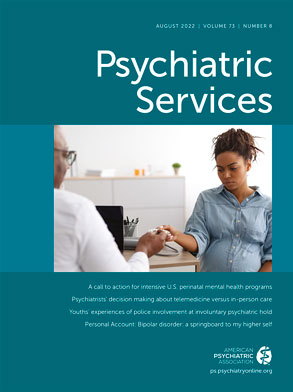Few options are available in the United States for women to receive intensive perinatal mental health treatment, especially for women with low incomes. Despite the growth of intensive perinatal mental health programs across the United States over the past 5 years, there appears to be an inadequate number of such programs nationally to serve the 15%−20% of women who experience perinatal mood and anxiety disorders (PMADs) (
1). In addition, these programs exist in only 13 states. With 3.8 million annual births in the United States (
2), approximately one intensive perinatal mental health treatment program is currently available for every 21,000 women with PMADs. Without access to specialized treatment, these women are at risk for chronic and treatment-resistant mental health problems, suicide, dysfunctional family relationships, and poor self-care (
3). Moreover, their infants are at risk for behavioral, cognitive, socioemotional, and physical problems that can persist into adulthood (
4).
Several U.S. initiatives have highlighted the critical need for better perinatal mental health services; these include the Patient Protection and Affordable Care Act’s mandate for insurance companies to cover screening for postpartum depression (
5), the Black Maternal Health Momnibus Act of 2021 to support Black mothers with mental health challenges and substance use disorders (
6), and the U.S. Health and Human Services’ Call to Action to Improve Maternal Health (
7). However, these initiatives have not all been realized. Nonetheless, intensive perinatal mental health programs could address the gap in services and confer a range of benefits over traditional inpatient or outpatient care if they are supported systematically.
Inspired by specialized inpatient mother-infant units in Europe, Women and Infants Hospital in Rhode Island opened the first psychiatric mother-baby day treatment program in the United States in 2000 (
8). By 2015, four intensive perinatal mental health programs had been established, including our own program, Mother Baby Connections (
9), and by 2017–2018 (at the time of this investigation), there were 17, including 15 outpatient and two inpatient programs (
1). In general, these programs offer evidence-based treatment approaches from an interdisciplinary team; contact with other mothers through groups and informal interaction; and facilitation of physical, cognitive, behavioral, and emotional support for the mother while enhancing her relationship with her baby. Regular contact with other mothers through intensive perinatal mental health programs normalizes mental health challenges; decreases social isolation, shame, and stigma; and provides a structured community for peer support, education, role-modeling, and practical experience (
9). Moreover, intensive perinatal mental health programs provide welcoming settings, avoid separation from immediate family for extended periods of time, allow real-time observation of mother-infant dyadic behavior, and demonstrate role-modeling of positive maternal behaviors (
8). The literature to date concerning intensive perinatal mental health programs demonstrates positive treatment response and high rates of patient satisfaction (
8,
9). Thus, intensive perinatal mental health programs address many treatment needs of women with PMADs.
As clinical teams across the United States initiate new intensive perinatal mental health programs, understanding the key features of existing programs that likely promote positive outcomes is critical. Delineating programmatic and procedural commonalities and distinctions also can inform collaborations among programs. Although results disseminated by some programs address specific services provided and demonstrate positive outcomes on various indices (
8,
9), no report to date has characterized existing intensive perinatal mental health programs. We sought to answer the following service delivery questions: What are the characteristics of intensive perinatal mental health programs across the United States, including program operations, services offered, women served, and methods of collecting program outcomes? What recommendations can we offer as a call to action to better serve women in the United States with PMADs and their infants?
We began to learn about each program through an online open-ended survey developed by our team on the basis of our experience with Mother Baby Connections (
9). Program directors or their delegates answered the survey questions. To gain a deeper understanding of answers provided in our online survey, we visited each program and conducted an audio-recorded in-person interview with the program directors, clinical providers, and staff. We summarized findings from our online survey and used content analysis to evaluate the transcription of the audio-recorded interviews to answer our questions.
We found that most programs (for program and patient characteristics, see the
online supplement to this Open Forum) were intensive outpatient or partial hospitalization programs, with all but three located in nonacademic settings, including hospitals and private practices. Most had been in operation for 3 years or less. Collectively, the programs had served over 8,000 women. Reported treatment costs for women who self-paid ranged from $15 per week to $1,300 per day.
Programs were primarily directed by psychiatrists, followed by social workers, psychologists, nurses, and advanced practice nurses. Mental health staff represented a variety of disciplines. Most programs reported that clinical providers included trainees (e.g., medicine, nursing, psychology). Training included informal and formal education, and supervision but was not tracked systematically. Two sites mentioned using volunteers (e.g., for child care, yoga instruction, administrative tasks). Most programs reported holding regular (e.g., daily, weekly) staff care coordination meetings.
The mean number of women attending programs at any time was 12 (range 5–22), and the average duration of treatment was 18 days (range 7–35). Most programs reported that they also treated pregnant women. Although most programs could provide a general sense of patient attendance, they did not systematically track treatment completion (e.g., retention rates, reasons for discontinuation). Barriers to attendance reported by respondents were transportation, work, child care responsibilities, inconvenient program location, lack or loss of health insurance, high symptom severity, scheduling conflicts, lack of match with the program, psychosocial stressors, and moving.
Programs provided therapy in individual, group, mother-infant dyad, and family/couples formats. Most programs provided cognitive-behavioral therapy (
10), psychoeducation, parent-infant attachment support (e.g., circle of security, mother-baby interaction therapy) (
4,
11), and medication management. Other treatments included interpersonal psychotherapy (
12), dialectical behavioral therapy (
13), acceptance and commitment therapy (
14), and trauma therapy. Some programs also included complementary treatments (e.g., art therapy, infant massage, mindfulness, yoga, music therapy). Additional services included infant caregiving and patient navigation (
15). No program provided child care for older children.
We found that standardized measures to monitor women’s outcomes were not consistently used across programs. Three sites did not report collecting any outcome data. Fewer than four programs used standardized measures, including the Edinburgh Postnatal Depression Scale (
16) and seven-item Generalized Anxiety Disorder Scale (
17), or measured outcomes including maternal functioning, dyadic adjustment, parental stress, perceived stress, emotional regulation, insomnia, birth trauma, parental competency, perinatal anxiety, mania, work and social adjustment, and medication side effects. Five programs measured parental bonding with a variety of measures, and three provided infant developmental assessment.
Most women served by the programs were primiparas and were diagnosed as having major depressive disorder with peripartum onset and major depressive and/or generalized anxiety, panic, obsessive compulsive, and posttraumatic stress disorders. Most commonly, women were married or partnered, White, and had commercial insurance, followed by Medicaid. Some programs accepted payment on a sliding scale. Notably, medical assistance insurance in California did not allow payment for intensive perinatal mental health services.
Discussion and Implications
The U.S. intensive perinatal mental health programs surveyed offer evidence-based treatments by interdisciplinary providers in various settings, but program data are limited, and no known published collective review of these programs exists. In addition, although 27 programs are listed on the Postpartum Support International website to date (10 additional sites have been listed since our survey/interviews), there still appears to be too few geographically accessible programs to meet the needs of thousands of women and their infants who experience PMADs. Overall, intensive perinatal mental health programs have the potential to increase access to specialty treatment among women who experience PMADs. Based on what we learned, we recommend forming a national consortium as a forum for the exchange of ideas, thereby promoting collaboration across programs and implementation of key agenda items. Our recommendations for consortium action include the following.
Standardize data collection.
Specifically, the consortium could create a standardized evaluation protocol comprising reliable and valid clinical outcome measures. Resulting data could generate a national database for collaborative research and generate evidence for advocacy and policy, including for adequate programmatic funding.
Maintain an updated database on key characteristics of existing and new programs.
A national program database of key program characteristics could facilitate timely and appropriate referrals for women who experience PMADs. This information could also be used to identify standard program components necessary to provide high-quality intensive perinatal mental health care.
Advocate for funding and policy development.
Programs could work collectively to advocate for intensive perinatal mental health treatment policy initiatives and identify effective solutions to barriers to care in order to enable women to participate in treatment.
Recommend core evidence-based services to be offered across all programs.
The consortium could identify core evidence-based services, such as psychotherapies, parent-infant attachment support, care coordination meetings, patient navigation, and infant developmental evaluations.
Establish regional plans for geographically accessible programs.
To establish plans for geographically accessible programs across the United States, a consortium could identify regions in need and provide consultation for development of new programs and innovative ways to increase access to existing programs. For example, the use of telehealth could improve patient access to services in intensive perinatal mental health “treatment deserts.”
Increase the number of providers.
To increase the number of perinatal mental health treatment providers, the consortium could identify and share novel methods to integrate training into clinical services. Transdisciplinary training could include medicine (e.g., psychiatry, OB/GYN, pediatrics), psychology, nursing, social work, physical therapy, and creative arts therapies.
Conclusions
In closing, coordinated efforts among existing programs could help to achieve the important next steps to improve the mental health and well-being of perinatal women with PMADS and their infants and families across the United States.

